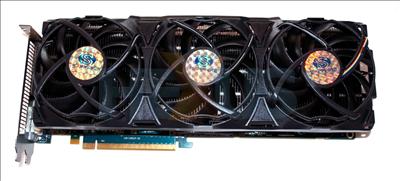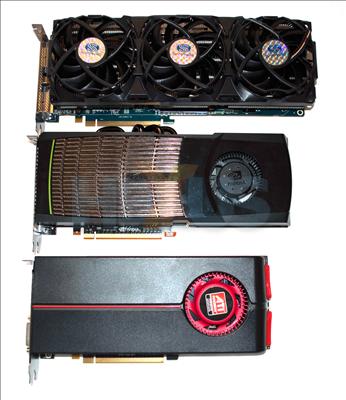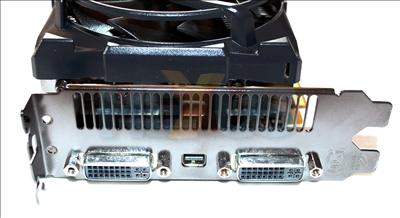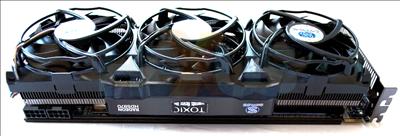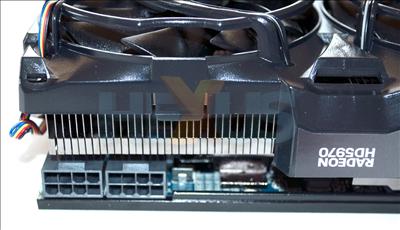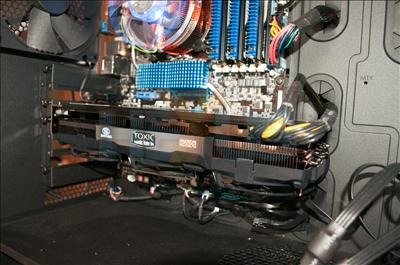Not just another Radeon HD 5970
Considering that AMD already has the fastest single graphics card in its arsenal, you might be thinking somewhere along the lines of "if it ain't broke..."
A valid argument, but it's entirely possible that AMD and Sapphire felt NVIDIA's Fermi would pose a bigger threat, and the Radeon HD 5970 TOXIC 4GB might have been conceived as an attempt to scupper NVIDIA's best effort.
As it stands, the card's goal is far more straightforward - it needs to beat the reference Radeon HD 5970 in terms of single-card performance.
A massive 4GB frame buffer will certainly help, but there's plenty more on offer than that. Jog through your memory banks and you may remember the Radeon HD 5970 wasn't called the Radeon HD 5870 X2 for a reason. Knowing that the card wasn't quite a doubling-up of AMD's fastest single GPU, the X2 nomenclature was dropped to represent the fact that a stock HD 5970 is a blend of HD 5870 architecture and HD 5850 speeds.
How do you improve on that? The answer's obvious; go all out and put two full-fat HD 5870 GPUs on a single board, creating a new breed of card that for all intents and purposes is effectively an HD 5870 X2. But why stop at that? Keeping true to its TOXIC line, Sapphire then attaches a mammoth 4GB frame buffer and a sprinkling of factory-overclocked frequencies.
That leaves you with the same 3,200 stream processors, but a little more in terms of everything else - the card's dual GPUs are ramped up from 725MHz on the reference design to an incredible 900MHz on the TOXIC, and the 4GB of GDDR5 memory clocks in at an effective 4,800MHz - an increase of 800MHz.
Sounds ludicrous - and it arguably is - but there's one immediate downside; this is a card that's going to need some serious cooling.
That'd be why Sapphire has teamed up with Swiss thermal specialist Arctic Cooling to equip the card with a beefy derivative of the Accelero XTREME cooler.
The gargantuan heatsink - accompanied by a trio of 92mm fans - is employed to keep the card from spontaneously combusting, and it's seemingly well equipped for the task. Eight fat-looking heatpipes run along the length of the card, and around 120 fins help dissipate heat.
Measuring close to 12in in length, it's every bit as colossal as it looks. At almost 60mm thick, it's also a bit on the fat side and occupies the best part of three expansion slots. You'll need to ensure it's screwed in tight, too, as it tips the scales at 1,142g.
Putting the size into perspective, here's Sapphire's Radeon HD 5970 TOXIC 4GB sitting alongside NVIDIA's GeForce GTX 480 and an ATI Radeon HD 5850.
There's no change in terms of connectivity, though. Like the reference HD 5970s already on the market, Sapphire's TOXIC 4GB edition offers an Eyefinity-enabled trio consisting of two DVI ports and mini-DisplayPort.
If you're spending serious amounts of money on your graphics card - say around £750 including VAT - you're going to want to a card that looks as menacing to the eye as it is to the wallet. Sapphire's 5970 TOXIC 4GB fits the bill.
You'll notice there's a single CrossFire link, too, in case you're brave enough to tie two of these together for four-GPU CrossFire action. Well-spaced PCIe slots are going to be required, and you may finally have found a use for your 1,200W+ power supply.
Given that the card offers plenty more than a reference HD 5970, it's no surprise to find it'll need a little more power, too. A duo of eight-pin connectors help provide the juice, and Sapphire recommends at least an 850W power supply.
Heatpipes, heatpipes and more heatpipes.
Appearances can be deceiving - the card looks diminutive in a capacious Corsair Obsidian Series 800D chassis, but it easily dwarfs the width of an ATX motherboard.
We try not to judge a book by its cover, but both the card's aesthetics and specifications suggest it'll be faster, cooler and possibly quieter than AMD's reference HD 5970 design. Can't be a bad thing, can it?






